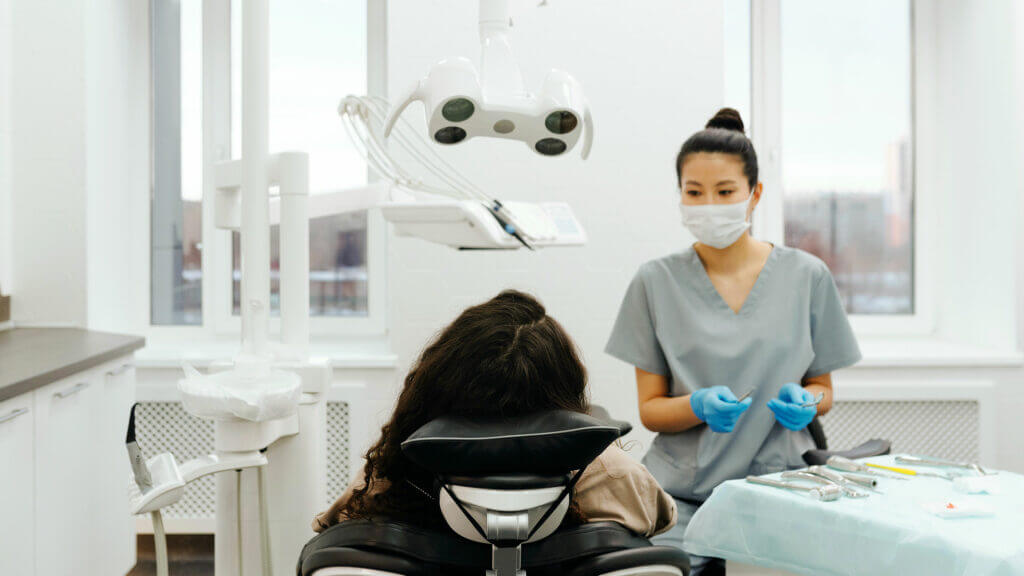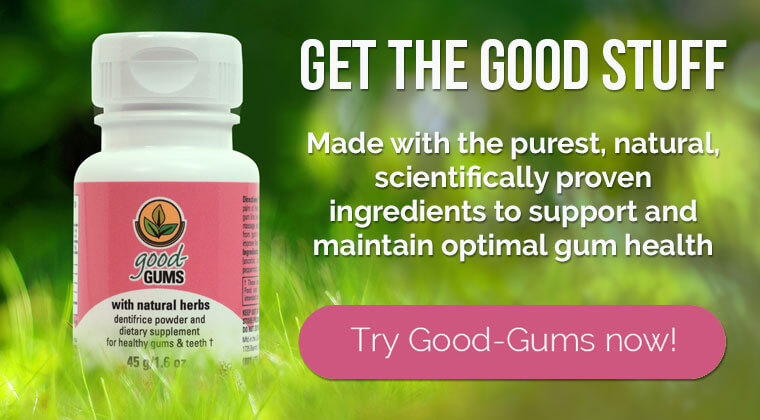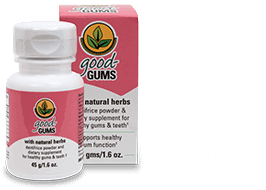KEEPING YOUR MOUTH CLEAN AND GUMS INFECTION FREE
Part 2 of our series of Reference Articles explaining the proven science behind the Good-Gums, how it works so well, and why. Read article 1 – Read article 3.
An important aspect of how the Good-Gums formula works is found in its anti-microbial properties. Together with its other primary functions, this is a main reason why its effectiveness in tackling a range of gum issues including gum disease, bleeding gums, infected gums & periodontitis, receding gums and the restoration of gum tissue.
In this article we focus on ingredients in the Good-Gums formula which have anti-microbial properties and why this is an important part of reestablishing and maintaining optimal gum and oral health.

THE ANTI-MICROBIAL PROPERTIES OF GOOD-GUMS AND THEIR EFFECT ON ORAL HEALTH AND GUMS
The Good-Gums formula contains ingredients shown to actively support the growth of new healthy gum cells, which is critical to restoring your gums to health. But in addition, Good-Gums also contains ingredients shown to have antimicrobial effects, which is important to keep your gums from being re-infected by the same microbes that originally caused your current gum problems that you’re already trying to reverse. Stopping future re-infection doesn’t actively support the growth of healthy new gum cells; that’s accomplished by other nutrient ingredients that are particular to Good-Gums. But stopping future re-infection does keep you from fighting against your own efforts to restore the health of your gums. (If you look carefully at the claims by competitors’ products, they attempt only to decrease bacterial populations, leaving you with none of the help that Good-Gums provides in restoring already-compromised gum tissue.)
As for the anti-microbial action, we don’t use artificial chemicals to kill microbes in the mouth, and we’re not trying to eliminate all microbes there. Achieving a sterile oral cavity would not only be impossible to achieve, but it would not be healthy. There are over 700 species of microbes in the mouth, a few of which are harmful (by causing gum disease and caries) and many of which are beneficial (by starting the process of digestion or by filling up the oral environment to crowd out spaces otherwise available for harmful microbes). (1) But the sugary and starchy foods in modern diets can still cause the populations of some ordinarily minority strains of bacteria to explode in numbers. These huge populations are particularly vulnerable to the natural anti-microbial ingredients of Good-Gums, affecting them more than the smaller populations of the good bacteria.
The anti-microbial ingredients selected for Good-Gums exert their properties not just redundantly, but via a variety of different biological mechanisms, from increasing white blood cells, to inhibiting biofilm formation, to loosening the adhesion of oral bacteria, to osmotic dehydration of oral bacteria.
This article will review published articles and clinical trials that focus on the anti-microbial properties of these all-natural ingredients of Good-Gums:
- Myrrh
- Peppermint
- Cranberry
- Cinnamon
- and high-mineral French grey sea salt
Citations for the sources of the information are indicated by parentheses in the text.

ACTIVE, NATURAL, PLANT BASED ANTI-MICROBIAL INGREDIENTS IN GOOD-GUMS AND SCIENTIFIC PROOF OF EFFECTIVENESS
MYRRH
This natural plant resin is famous worldwide and since ancient times for its anti-microbial properties (as well as for its tissue-soothing properties, addressed in another of our webpages). But it’s not just ancient tradition that supports these claims. Modern research has confirmed myrrh’s anti-microbial activity in the body, and also specifically in the mouth. Science has discovered the mechanisms by which myrrh boosts the body’s anti-microbial defenses, and has demonstrated both its safety and its ability to evade the resistance that microbes often develop against most other(and especially synthetic) anti-microbials. We’ll quickly survey each of these claims and research supporting them.
A peer-reviewed scientific article published in 2003 found that “myrrh has considerable antimicrobial activity and is medicinally used in a variety of diseases.” (2) A research paper “showed antibacterial and antifungal activity against standard pathogenic strains” of various species of pathogenic microbes. (3) The genus Commiphora (myrrh) is “exploited as a natural drug to treat pain, skin infection, inflammatory conditions, … and periodontal disease.” Products derived from C. myrrha are “becoming recognized to possess significant antiseptic, anesthetic and antitumor properties.” (4) Another report on the medicinal properties of myrrh cites its antimicrobial, astringent, anti-inflammatory and antiseptic properties. (5) Research showed that a group of compounds in myrrh known as sesquiterpene lactones have strong antibacterial and antifungal activity. (6)
Besides the general antimicrobial activity of myrrh, a number of scientific papers and clinical trials reported on the antimicrobial effectiveness of myrrh specifically in the mouth. (7), (8), (9), (10), (11) While not a report of a specific clinical trial, the RxList (a list of medicines maintained by WebMD) cites myrrh’s being “applied directly to the mouth for soreness and swelling, inflamed gums (gingivitis), loose teeth, canker sores.” (12)
Scientists have found specific biological mechanisms by which myrrh exercises its antimicrobial activity. Interestingly, besides anti-inflammatory compounds that help the body reduce pain and swelling, myrrh also causes a rise in the number of white blood cells (leukocyte immune cells) throughout a healing period to hasten the healing process. (13), (14), (15), (16), (17)
Confirming thousands of years of tradition, the use of myrrh was found to be safe. “Among the antimicrobial agents, Commiphora myrrha [myrrh] is considered as natural and safe materials. The antimicrobial activity of Commiphora myrrha essential oil against different species of pathogenic gram-positive as well as gram-negative bacteria were investigated. Data revealed that all tested microorganisms were susceptible to the action of Commiphora myrrha.” (18), (19)
A noteworthy property of myrrh is that it was found not to cause the strains of bacteria that were exposed to it to develop any future resistance, even after multiple exposures. A 2020 study found this to be so significant that it said that “myrrh resin can be a promising source of a future antibiotic” (20), with the added advantage of myrrh’s being a natural herb.
PEPPERMINT
Peppermint is considered in the western world as the oldest medicine, with early human populations discovering and taking advantage of its healing properties. Medicinal uses date back to the herbal pharmacopoeia of ancient Greece, and dried peppermint leaves have been found in Egyptian pyramids. (21), (22), (23).
A number of studies by modern researchers have tested peppermint and documented its “significant antibacterial and antiviral properties” against a range of microbial species, including some that are found in the mouth. Also noteworthy, peppermint has been found to be effective against biofilm formation. (, (25), (26), (EC-27) Peppermint also has been shown to have strong antioxidant actions. (28), (29)
A very interesting and useful property of peppermint (especially for a product like Good-Gums that is absorbed by the gums) is that the menthol in peppermint can enhance penetration by other agents by affecting the permeability of cell membranes. (30), (31)
Please note that Good-Gums does not use the processed (steam-distilled or chemically-extracted) essential oil of peppermint, which can be quite intense on sensitive soft oral tissues. Instead Good gums uses the whole leaf, simply dried and powdered, as humans have successfully used for millennia.
CRANBERRY
It may seem to be a humble plant, but its fruit includes a little-known property that is amazingly valuable for supporting oral health. It is well-known that the fruit of cranberry is high in antioxidants, particularly in phenols, having a much higher concentration than any other of the 20 most common fruits. They’re also high in anthocyanins. They’re high in vitamin C, and contain many other vitamins as well (such as vitamin A, K, E, and B-complex vitamins. (The vitamin content diminishes as the fruit dries.) They also contain many essential minerals, such as potassium, calcium, manganese and copper. (32)
But the unusually helpful (for oral health) property of cranberry is its antibacterial effects against periodontal pathogens. When in a planktonic state (when floating as individual, disorganized bacteria) and when exposed to cranberry, there is a significantly reduced viability of the bacteria that form the biofilm of plaque: Stretocccus oralis, Actinomyces naeslundit, Veillonella parvula, Fusobacterium nucleatum, Porphyromonas gingivalis, and aggregatibacter antinomycetemcomitans. But even when the bacteria have started to form biofilms (i.e., plaque colonies), cranberry also exerts a significant antibacterial effect. (33)
The precise biological mechanism that makes cranberry so effective against oral pathogens is that it “significantly decreases nonoscale adhesion forces” of the oral pathogenic bacteria. The bacteria have small, hair-like projections called fimbriae that reach out from each bacterium to latch onto victim epithelial cells (cells of the lining of tissue, such as of the gums or urinary tract). When enough bacterial cells adhere to epithelial cells, they cause an infection. In fact, the adhesion by the fimbriae is essential for infection. But exposing the cells to cranberry causes fimbriae of the bacteria to curl up, into a position in which they cannot grip epithelial cells. As more of a bacterium cell’s fimbriae curl up, the less that the bacterium can hold on to its “victim” tissue, so that the bacterium can be removed much more easily with much less force. For a urinary tract infection, just the flow of urine through the urinary tract is enough to dislodge many of the bacteria and to flush them out of the body, thereby shortening the time to achieving a recovery from the infection. In the mouth, the grip of the plaque-forming bacteria can be loosened to the extent that the bristles of a toothbrush are enough to dislodge them. (34), (35). This is the mechanism employed by Good-Gums, rather than employing abrasives (common to all tooth pastes and to other anti-plaque products) that use their abrasives to grind off the colonies of strongly-adhering plaque bacteria (while also scratching enamel). We think that reducing the grip of bacteria so that it becomes easy to brush away is a more effective approach, without the damaging side effects.
CINNAMON
Widely known as a flavoring and culinary spice, it’s fairly well known as a potent antioxidant and a very potent anti-inflammatory herb. (36) (37), (38) But less widely known is cinnamon’s antimicrobial properties. The oil that is naturally and inherently present in the bark of cinnamon inhibits the growth of various strains of bacteria. (39)
But of even greater relevance for Good-Gums is the research s that showed cinnamon’s effectiveness against oral pathogenic microbes, cited for its “robust antibacterial activities.” (40), (41) , (42) Besides killing oral pathogens responsible for infecting the gums, cinnamon also has been proven to interfere with the formation of oral biofilms, both when formed by single bacterial species of oral bacteria and when oral biofilms were formed by multi-species, their maturation being significantly inhibited by cinnamon. (43). This is significant because the development of oral biofilms (known as plaque) is the primary mechanism used by oral pathogens to set up colonies capable of infecting the gums.
FRENCH GREY SEA SALT
This sought after high-mineral sea salt is harvested from one of the cleanest parts of the ocean, the Atlantic coast of Brittany, France. (HE-44), (HD-45) The practice of saltwater rinses following oral surgery, such as tooth extraction, is universally recommended by dentists, and its value has been proven in randomized controlled clinical trials. (46)
But seawater and saltwater have also been shown to have antimicrobial effects. One study says that salt water may be considered as effective as chlorhexidine (the “gold standard” for synthetic oral rinses) for dental plaque control. (47) A study compared the results of using salt water rinses on some students and chlorhexidine on others for five days, and found that “salt water is effective against reducing dental plaque and the salivary oral bacterial count.” (48) The study found that a mechanism for its antimicrobial action is that “water moves out of the cell by osmosis” and that “oral bacteria become dehydrated and eventually die within a minute.”

By combining all these different antimicrobial effects from the different ingredients, Good-Gums achieves an antimicrobial effect that helps the gums avoid ongoing reinfection while they’re using other nutritional ingredients of Good-Gums to support the growth of healthy new gum cells. It really is a balanced synergistic formula of full support.
We hope you’ve enjoyed learning this information about your gums.
Now that you’ve gotten some insight into the anti-microbial properties of the Good-Gums formula and its role in gum care, you can start taking control of your own oral health. So whether you want to treat gum disease, restore receding gums or tackle periodontitis, you can rest assured that Good-Gums has the power to support your healing and that it’s backed by good science.
Purchase your first bottle now and get started.

CITATIONS – PEER REVIEWED STUDIES, REPORTS AND ARTICLES ON THE MICROBIAL PROPERTIES OF GOOD-GUMS INGREDIENTS
(1) Mouth Microbes; National Institute of Craniofacial Research; 2019; https://www.nidcr.nih.gov/news-events/nidcr-news/2019/mouth-microbeshttps://www.nidcr.nih.gov/news-events/nidcr-news/2019/mouth-microbes
(2) Components, Therapeutic Value and Uses of Myrrh; Pharmazie; 2003 Mar; by E S H El Ashry , N Rashed, O M Salama, A Saleh; https://pubmed.ncbi.nlm.nih.gov/12685809/
(3) Local Anaesthetic, Antibacterial and Antifungal Properties of Sesquiterpenes from Myrrh; Planta Medica; June 2000; by Dolara, Piero & Corte, Barbara & Ghelardini, Carla & Pugliese, Anna & Cerbai, Elisabetta & Menichetti, Stefano & Lo Nostro, Antonella; https://www.researchgate.net/publication/12454253_Local_Anaesthetic_Antibacterial_and_Antifungal_Properties_of_Sesquiterpenes_from_Myrrh
(4) An Update Review on Commiphora Molmol and Related Species; Journal of Egyptian Society of Parasitology; 2008 Dec; by Abdulkader M D Tonkal , Tosson A Morsy; https://pubmed.ncbi.nlm.nih.gov/19209761/
(5) Medicinal Properties of Myrrh; WRIC Health, Medicinal Plants; 2018; https://wric-health.com/eng/medicinal-plants/medicinal-properties-of-myrrh/
(6) MYRRH; The Benefits of the Use of Myrrh in Herbal Preparations; by Rebecca Joy Knottnerus; https://www.herballegacy.com/Knottnerus_Medicinal.html
(7) Efficacy of Commiphora Myrrh Mouthwash on Early Wound Healing After Tooth Extraction: A Randomized Controlled Trial; The Saudi Dental Journal.; 2021 Jan; by Raniah Abdullah Al Eid; https://pubmed.ncbi.nlm.nih.gov/33473242/
(8) Antimicrobial Activity of Yemeni Myrrh Mouthwash; Journal of Chemical and Pharmaceutical Research, 2014, 6(5):1006-1013; by Sadik Almekhlafi, Anes A. M. Thabit, Ameen M. I. Alwossabi, Nasser Awadth; https://www.jocpr.com/articles/antimicrobial-activity-of-yemeni-myrrh-mouthwash.pdf
(9) MYRRH; The Benefits of the Use of Myrrh in Herbal Preparations; by Rebecca Joy Knottnerus; https://www.herballegacy.com/Knottnerus_Medicinal.html
(10) An Update Review on Commiphora Molmol and Related Species; Journal of Egyptian Society of Parasitology; 2008 Dec; by Abdulkader M D Tonkal , Tosson A Morsy; https://pubmed.ncbi.nlm.nih.gov/19209761/
(11) Medicinal Properties of Myrrh; WRIC Health, Medicinal Plants; 2018; https://wric-health.com/eng/medicinal-plants/medicinal-properties-of-myrrh/
(12) MYRRH; RxList; vitamins, herbs, dietary supplements a-z list; myrrh; Reviewed on 6/11/2021; vitamins, herbs, dietary supplements a-z list myrrh; https://www.rxlist.com/myrrh/supplements.htm
(13) Effect of Commiphora Molmol on Leukocytes Proliferation in Relation to Histological Alterations Before and During Healing From Injury; Saudi Journbal of Biological Sciences; 2010; by Al-Said A Haffor; https://pubmed.ncbi.nlm.nih.gov/23961070/
(14) Health Benefits Of Myrrh; Health Prep; by HealthPrep Staff; https://healthprep.com/living-healthy/health-benefits-myrrh/
(15) Effect of Myrrh (Commiphora molmol) on Leukocyte Levels Before and During Healing From Gastric Ulcer or Skin Injury; Journal of Immunotoxicology; 2010 Mar; by Al-Said A Haffor; https://pubmed.ncbi.nlm.nih.gov/19995243/
(16) Medicinal Properties of Myrrh; WRIC Health, Medicinal Plants; 2018; https://wric-health.com/eng/medicinal-plants/medicinal-properties-of-myrrh/
(17) MYRRH; The Benefits of the Use of Myrrh in Herbal Preparations; by Rebecca Joy Knottnerus; https://www.herballegacy.com/Knottnerus_Medicinal.html
(18) Impact of Myrrh Essential Oil as a Highly Effective Antimicrobial Agent in Processed Cheese Spreads; International Journal of Dairy Science 11(2):41-51; February 2016; by A.G. Mohamed; https://www.researchgate.net/publication/295102142_Impact_of_Myrrh_Essential_Oil_as_a_Highly_Effective_Antimicrobial_Agent_in_Processed_Cheese_Spreads
(19) MYRRH; The Benefits of the Use of Myrrh in Herbal Preparations; by Rebecca Joy Knottnerus; https://www.herballegacy.com/Knottnerus_Medicinal.html
(20) Antibiotic in Myrrh from Commiphora Molmol Preferentially Kills Nongrowing Bacteria; Future Science OA; 2020 Apr; by Mrinal K Bhattacharjee*, and Tahrir Alenezi; https://www.ncbi.nlm.nih.gov/pmc/articles/PMC7117549/
(21) Peppermint Oil; American Family Physician. 2007; by Benjamin Kligler, M.D., M.P.H., and Sapna Chaudhary, D.O.; https://www.aafp.org/pubs/afp/issues/2007/0401/p1027.html
(22) History of Peppermint; Peppermint Medicinal Use in History; https://www.youngliving.com/en_GB/discover/history-of-essential-oils/History-of-Peppermint
(23) Peppermint History – Exploring the Historical Roots; LivSeaSun blog; https://livseasun.com/peppermint-history-exploring-historical-roots/
(24) Essential Oils: Their Antibacterial Properties and Potential Applications in Foods–a Review; International Journal of Food Microbiology; 2004 Aug; https://pubmed.ncbi.nlm.nih.gov/15246235/
(25) Antibacterial and Anti-Biofilm Activities of Peppermint Essential Oil Against Staphylococcus Aureus; LWT Food Science Journal; Volume 101, March 2019, Pages 639-645; by Jiamu Kang, Wenyuan Jin, Jingfan Wang, Yuyang Sun, Xiaoxia Wu, Liu Liu; https://doi.org/10.1016/j.lwt.2018.11.093
(26) Staphylococcus Aureus and the Oral Cavity: an Overlooked Source of Carriage and Infection?; American Journal of Infection Control; 2015 Jan; by M G McCormack, A J Smith, A N Akram, M Jackson, D Robertson, G Edwards; https://pubmed.ncbi.nlm.nih.gov/25564121/
(27) A Review of the Bioactivity and Potential Health Benefits of Peppermint Tea (Mentha piperita L.); Phytotherapy Research; 2006 Aug;20(8):619-33.; by Diane L McKay, Jeffrey B Blumberg; https://pubmed.ncbi.nlm.nih.gov/16767798/
(28) Ibid.
(29) Peppermint Herb Nutrition Facts; Nutrition and You; https://www.nutrition-and-you.com/peppermint.html
(30) Final Report on the Safety Assessment of Mentha Piperita (Peppermint) Oil, Mentha Piperita (Peppermint) Leaf Extract, Mentha Piperita (Peppermint) Leaf, and Mentha Piperita (Peppermint) Leaf Water; International Journal of Toxicology; 2001; by B Nair; https://pubmed.ncbi.nlm.nih.gov/11766133/
(31) Antibacterial and Anti-Biofilm Activities of Peppermint Essential Oil Against Staphylococcus Aureus; LWT Food Science Journal; Volume 101, March 2019, Pages 639-645; by Jiamu Kang, Wenyuan Jin, Jingfan Wang, Yuyang Sun, Xiaoxia Wu, Liu Liu; https://doi.org/10.1016/j.lwt.2018.11.093
(32) Cranberries; WebMD; by Angela Nelson; Medically Reviewed by Neha Pathak, MD on September 21, 2020; https://www.webmd.com/food-recipes/health-benefits-cranberries
(33) New Evidences of Antibacterial Effects of Cranberry Against Periodontal Pathogens; Foods; MDPI; 2020 Feb; by María C. Sánchez, Honorato Ribeiro-Vidal, Begoña Bartolomé, Elena Figuero, M. Victoria Moreno-Arribas, Mariano Sanz, and David Herrera1; https://www.ncbi.nlm.nih.gov/pmc/articles/PMC7074180/
(34) Cranberry’s Antibacterial Properties; Wellness Resources; summary of: Direct Adhesion Force Measurements Between E. coli and Human Uroepithelial Cells in Cranberry Juice Cocktail; Nutrition & Food Research; 2010 June; Worcester Polytechnic Institute; by Yatao Liu, Paola A. Pinzón-Arango, Amparo M. Gallardo-Moreno, Terri A. Camesano; https://www.wellnessresources.com/studies/cranberrys-antibacterial-properties
(35) Fimbriae, What is Fimbriae?; Vedantu; https://www.vedantu.com/biology/fimbriae
(36) Anti-inflammatory Activity of Cinnamon (C. zeylanicum and C. cassia) Extracts – Identification of E-cinnamaldehyde and O-methoxy cinnamaldehyde as the Most Potent Bioactive Compounds; Food & Function, comparative study; 2015 Mar; by Dhanushka Gunawardena , Niloo Karunaweera, Samiuela Lee, Frank van Der Kooy, David G Harman, Ritesh Raju, Louise Bennett, Erika Gyengesi, Nikolaus J Sucher, Gerald Münch; https://pubmed.ncbi.nlm.nih.gov/25629927/
(37) Cinnamon: a Multifaceted Medicinal Plant; Evidence-Based Complementary and Alternative Medicine; 2014 Apr; by Pasupuleti Visweswara Rao , Siew Hua Gan; https://pubmed.ncbi.nlm.nih.gov/24817901/
(38) Anti-Oxidant Effects of Cinnamon (Cinnamomum verum) Bark and Greater Cardamom (Amomum subulatum) Seeds in Rats Fed High Fat Diet; Indian Journal of Experimental Biology; 1999 Mar;37(3):238-42; by J N Dhuley; https://pubmed.ncbi.nlm.nih.gov/10641152/
(39) Antimicrobial Activities of Cinnamon Oil and Cinnamaldehyde From the Chinese Medicinal Herb Cinnamomum Cassia Blume; The American Journal of Chinese Medicine 2006;34(3):511-22; by Linda S M Ooi, Yaolan Li, Sheung-Lau Kam, Hua Wang, Elaine Y L Wong, Vincent E C Ooi; https://pubmed.ncbi.nlm.nih.gov/16710900/
(40) Anti-Bacterial Activity of Cinnamon Oil on Oral Pathogens; The Open Conference Proceedings Journal, 2013, 4: 12-16; by Zamirah Zainal-Abidin, Shahida Mohd-Said, Fadzilah Adibah, Abdul Majid, Wan Aida Wan Mustapha, Ibrahim Jantan; https://benthamopen.com/ABSTRACT/TOPROCJ-4-2-12
(41) Efficacy of Citronella and Cinnamon Essential Oils on Candida Albicans Biofilms; Acta Odontologica Scandinavica 2016 Jul;74(5):393-8.; by Leopoldina de Fátima Dantas de Almeida, Jacqueline Felipe de Paula, Rossana Vanessa Dantas de Almeida, David Wynne Williams, Josimeri Hebling, Yuri Wanderley Cavalcanti; https://pubmed.ncbi.nlm.nih.gov/27098375/
(42) Antibacterial Activity of Essential Oils Against Oral Pathogens; Chemistry & Biodiversity; Wiley-VHCA; 2022; by T. A. S. Oliveira, M. B. Santiago, V. H. P Santos, E. O. Silva, C. H. G. Martins, A. and E. M. Crotti
(43) Antibacterial and Antibiofilm Activities of Cinnamon Essential Oil Nanoemulsion Against Multi-Species Oral Biofilms; Scientific Reports. 2021 Mar; by Yeo-Jin Jeong, Hee-Eun Kim, Su-Jin Han, and Jun-Seon Choi; https://www.ncbi.nlm.nih.gov/pmc/articles/PMC7971021/
(44) Toxic and Carcinogenic Plastics are Found in Fifteen Sea Salt Brands from Different Countries; The Daily Health Post; https://dailyhealthpost.com/microplastics-in-the-ocean/2/
Excerpt: “France, on the other hand, was the only country with a clean sample that contained no MPs.”
(45) The Presence of Microplastics in Commercial Salts From Different Countries; Scientific Reports volume 7; April 2017; by Ali Karami, Abolfazl Golieskardi, Cheng Keong Choo, Vincent Larat, Tamara S. Galloway & Babak Salamatinia; https://www.nature.com/articles/srep46173#conclusions
Excerpt: “The number of anthropogenic particles (MPs and pigments) detected in the salt samples ranged from 0 (sample # France-F) to 10 (sample # Portugal-N) MPs/Kg.”
(46) Salt Water Mouthwash Post Extraction Reduced Post Operative Complications; Evidence Based Dentistry . 2015 Mar; 16(1):27-8.; by Matthew Stewart , Emily Levey , Namita Nayyer; https://pubmed.ncbi.nlm.nih.gov/25909940/
(47) Chemical Composition Of Seawater; Surf Researcher; https://centerforsurfresearch.org/chemical-composition-of-seawater/
(48) Comparative Evaluation of Salt Water Rinse With Chlorhexidine Against Oral Microbes: A School-Based Randomized Controlled Trial; Journal of the Indian Society of Pedodontics and Preventive Dentistry; 2017, Volume : 35, Issue : 4, Page : 319-326; by V Aravinth, MB Aswath Narayanan, SG Ramesh Kumar, A Leena Selvamary, A Sujatha; https://www.jisppd.com/article.asp?issn=0970-4388;year=2017;volume=35;issue=4;spage=319;epage=326;aulast=Aravinth
Read the other two articles in this series here:
Good Gum Science #1 – Ingredients that support the growth of healthy new gum cells
Good Gum Science #3 – Tissue-Soothing Ingredients
Or visit our Reference Articles Introduction Page.


